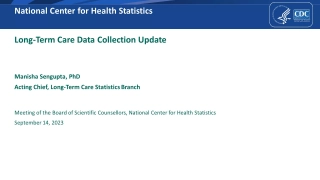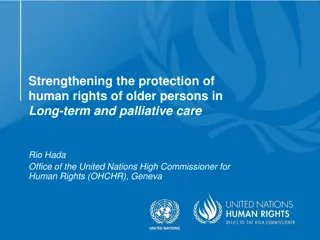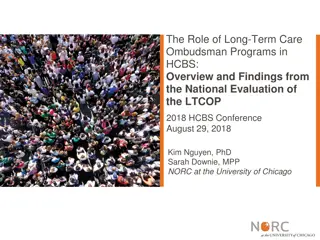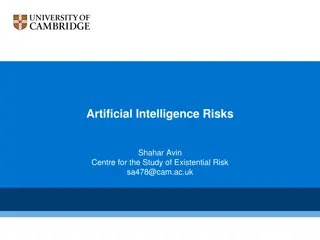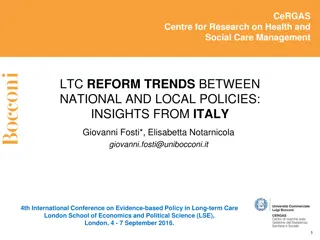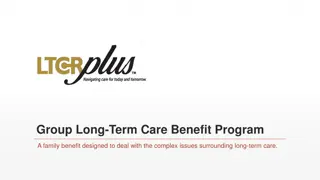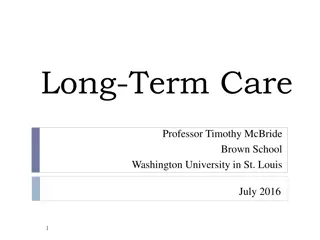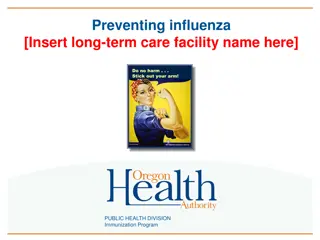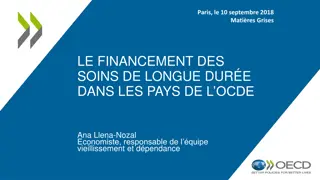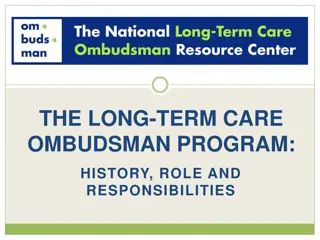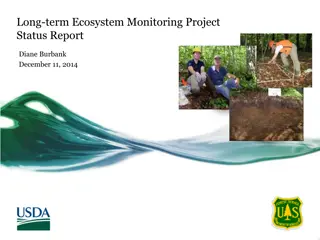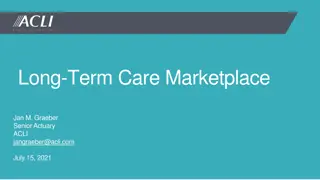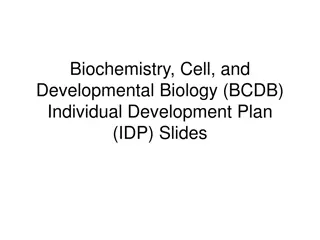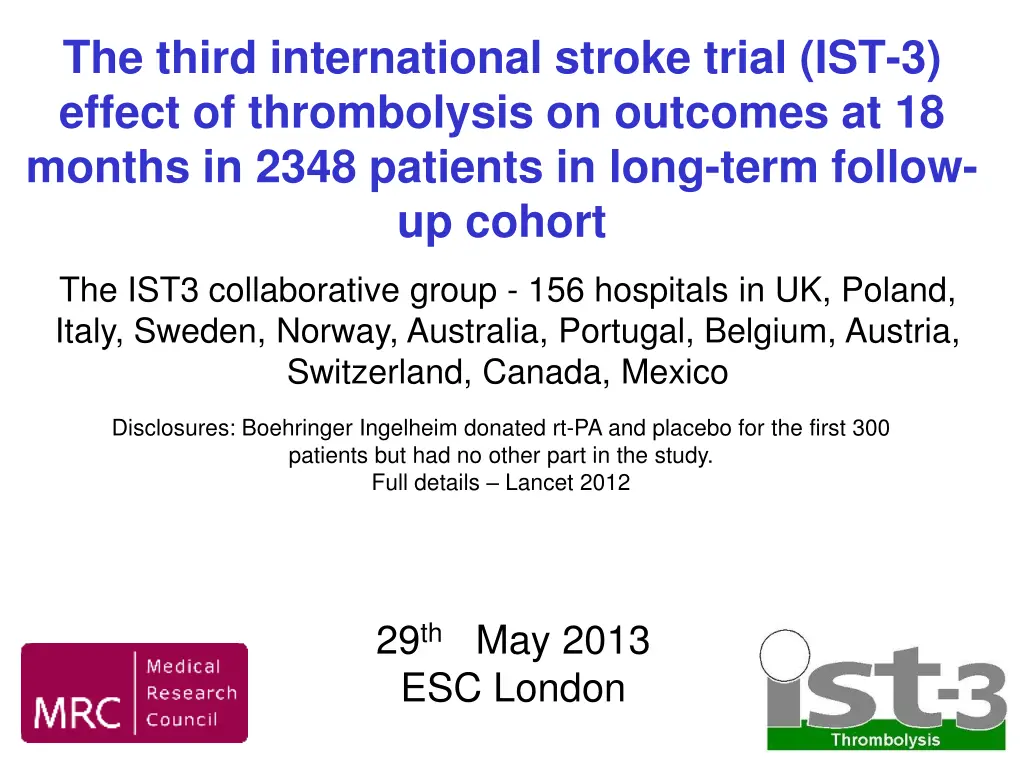
International Stroke Trial IST-3 Thrombolysis Outcomes
Long-term follow-up study on the effect of thrombolysis in stroke patients, evaluating outcomes at 18 months including survival, quality of life, and independence. The study involved 2348 patients from various countries and revealed promising results regarding patient independence.
Download Presentation

Please find below an Image/Link to download the presentation.
The content on the website is provided AS IS for your information and personal use only. It may not be sold, licensed, or shared on other websites without obtaining consent from the author. If you encounter any issues during the download, it is possible that the publisher has removed the file from their server.
You are allowed to download the files provided on this website for personal or commercial use, subject to the condition that they are used lawfully. All files are the property of their respective owners.
The content on the website is provided AS IS for your information and personal use only. It may not be sold, licensed, or shared on other websites without obtaining consent from the author.
E N D
Presentation Transcript
The third international stroke trial (IST-3) effect of thrombolysis on outcomes at 18 months in 2348 patients in long-term follow- up cohort The IST3 collaborative group - 156 hospitals in UK, Poland, Italy, Sweden, Norway, Australia, Portugal, Belgium, Austria, Switzerland, Canada, Mexico Disclosures: Boehringer Ingelheim donated rt-PA and placebo for the first 300 patients but had no other part in the study. Full details Lancet 2012 29th May 2013 ESC London
Background Most data from previous randomised trials based on short follow-up 10 trials (n=3343) follow-up at < 90 days NINDS (n = 624) at 3, 6 & 12 months No Quality of Life (QoL) data: ECASS-2 collected SF-36, but has not reported results
IST-3 Randomised controlled trial i.v. rt-PA vs. control (n= 3035) Primary outcome: % alive and independent Oxford Handicap Scale (OHS) 0-2 Follow-up at 7 days, 6 & 18 months
Aims and method Aim: at 18 months, assess survival, OHS, Quality of Life (EQ5D-3L, EQ index and VAS) & living circumstances Eligibility: patients recruited in the 10 countries participating in 18-mo. FU study. Method: postal questionnaire completed by patient or proxy or blinded telephone interview by national coordinating centre
18-month follow-up cohort Inclusion and baseline features 2348 eligible for inclusion in 18-month study Baseline characteristics similar to whole trial Treatment groups well balanced At 18 months, health related quality of life 44% completed by patient, 56% by a proxy EQ 5D utility index could be calculated from responses to EQ5D for 91% of survivors EQ VAS available for 90% of survivors
Independent (OHS 0-2) at 18 months rt-PA (n=1169) n (%) 391 (35%) control (n=1179) n 352 (%) (31%) Adjusted odds ratio 1.28 (95% CI 1.03-1.35), p = 0.024 = 36 more independent/1000
OHS at 18 months Control rt-PA No effect on death Favourable shift in OHS, Adjusted common odds ratio 1 30 (95% CI 1 10- 1 55), p=0 002
EQ5 domains,1 EQ utility index,2 VAS p EQ Domain Mobility Self-care Usual activities Pain or discomfort Anxiety or depression Difference in EQ utility index Difference in EQ-VAS 0 02 0 001 0 008 0 03 NS 0.03 NS 1. p for effect of treatment: ordinal analysis of 3 levels within each domain. 2. p for adjusted treatment difference in EQ index
Living at home at 18 months P = 0.05 85.0 83.9 rt-PA control % 16.1 15.0 Home Institution
At 18 months, i.v. rt-PA < 6hrs: No effect on survival Improved functional outcome (OHS) - 36 /1000 more alive and independent - Favourable shift in OHS grades p = 0.002 Quality of life: Significantly improved overall health (EQ utility index), mobility, self-care, usual activities, pain and discomfort No difference in anxiety/depression, overall health (VAS) No clear effect on % patients at home
Acknowledgements: The 3035 patients, 156 hospitals in the IST-3 group, 12 National Coordinators, Data Monitoring Committee, MRC Steering Committee, Image Reading Panel, Event adjudication panel,.
EUROQol 5 domains OR* (95% CI) p Domain Mobility 1 30 (1 05 - 1 61) 0 017 Self-care 1 43 (1 16 - 1 78) 0 001 Usual activities 1 32 (1 07 - 1 62) 0 008 Pain or discomfort 1 26 (1 02 - 1 56) 0 029 Anxiety or depression 1 05 (0 85 - 1 29) 0 668 *Adjusted common OR from ordinal analysis of 3 levels within each domain
Living circumstances at 18 months rt-PA N Own home 574 Control N 553 % 81 0 % 78 2 Relative's home 29 4 1 40 5 7 Institution 45 6 3 42 5 9 Nursing home 60 8 5 69 9 8 Still in hospital 1 0 1 3 0 4

